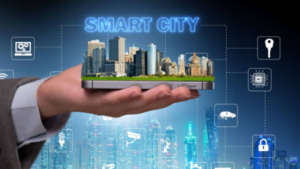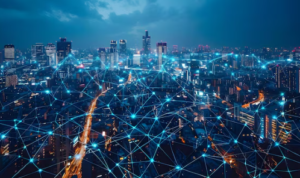
Technology and Development of Smart Infrastructure
Beginning
The way cities operate in the fast changing environment of today has been changed by including technology into infrastructure building. Innovative technologies drive smart infrastructure that not only increases efficiency but also raises resident quality of living. This paper explores how clever ideas are changing metropolitan environments by looking at the junction of infrastructure and technology.
Recognizing Intelligent Infrastructure
Smart infrastructure is what?
Smart infrastructure is the way digital technology are included into physical infrastructure. This covers public areas, utilities, buildings, and means of mobility. Systems that can interact, evaluate data, and change with the times are what are aimed at here. Cities may maximize resources and improve public participation by using Internet of Things (IoT) devices, artificial intelligence (AI) and big data.
Key components of smart infrastructure IoT sensors gather real-time data from several sources, including traffic patterns, ambient conditions, and energy consumption.
Advanced algorithms in data analytics process acquired data to offer insights and predictive analytics supporting decision-making.
High-speed internet and communication networks provide flawless interaction among devices and systems.
Smart technologies help to automate system control, therefore lowering the demand for human involvement and raising system efficiency.
Smart infrastructure sometimes include waste management technologies and energy-efficient structures meant to reduce environmental impact.
Technology’s Role in Infrastructure Development
improving urban mobility
Urban transportation is among the most important spheres in which technology is influencing. Many cities’ urgent problem of traffic congestion results in lost time and more pollution. Real-time data allows smart transportation systems to enhance traffic flow and ease congestion.
intelligent systems of transportation (ITS)
Its uses several technologies to control transportation services and traffic. Cities can track traffic conditions and change traffic signals by means of sensors and cameras. Furthermore, real-time data available to commuters via apps helps them to select the quickest paths.
Ecologically Friendly Energy Sources
City need for energy increases along with their size. Effective harnessing of renewable energy sources depends on smart infrastructure for cities. Smart grids, for instance, use sophisticated metering and data analytics to maximize energy distribution and lower waste.
Smart Grid Systems
An integral part of contemporary energy infrastructure are smart grids. They include solar and wind among other sustainable energy sources into the current infrastructure. They also enable two-way communication between consumers and utilities, therefore supporting demand response initiatives aiming at energy saving.
Water Management Novelties
In many cities, water shortage is a growing cause of worry. More effective management of water resources made possible by smart technologies guarantees sustainable use.
Smart Systems of Water
Sensors in smart water management systems track water use and quality in real-time. This information can assist in leak detection, water distribution optimization, and resident-based conservation initiatives promotion.
advantages of smart infrastructure enhanced efficiency
Including technology into infrastructure will help towns cut expenses and simplify processes. Automated solutions provide more effective use of money by completing activities hitherto requiring large human resources.
Improved Living Conditions
Better quality of life for citizens depends on smart infrastructure. Better public services, energy economy, and improved transportation networks help to define a more livable metropolitan environment.
Environmental sustainability
Including sustainable practices into smart infrastructure helps cities lower their environmental impact. Fighting climate change depends much on technologies that support resource management and energy economy.

Financial Expansion
Putting money into smart infrastructure can boost local businesses. Modernizing their infrastructure helps cities draw firms and provide employment, therefore strengthening their economy.
Obstacles in Adopting Smart Infrastructure
High Starting Prices
Although smart infrastructure offers many communities great long-term advantages, many of them find the upfront outlay frightening. Using new technologies and improving current systems calls for significant financing.
Concerns About Data Privacy
Data privacy presents a difficulty with the growth of IoT and data analytics. Developing confidence in smart infrastructure systems depends on the safety of personal data for citizens.
Integration with Historical Systems
Still many cities depend on antiquated infrastructure. Combining modern technology with old systems can be difficult and call for large amounts of time and money.
Legislative Obstacles
Government rules either help or impede the creation of smart infrastructure. Effective application depends on negotiating the regulatory terrain.
Cases Studies of Development of Smart Infrastructure
Barcelona: a Smart City Model
Barcelona is now one of the best models of smart city building. By means of its Smart City Strategy, the city has combined several technologies to enhance metropolitan living. Initiatives call for smart lighting, waste management systems and intelligent transportation options.
Smart Lighting
Barcelona’s smart lighting system lowers energy use and expenses by varying brightness depending on real-time data. Along with saving energy, this approach improves public safety.
Singapore : Savoring the Future
Singapore’s dedication to become a smart country is well-known. From integrated public transit systems to autonomous cars, the city-state has launched a variety of clever projects.
Independent cars
To increase transportation efficiency, Singapore is testing driverless cars. These cars are made to interact with current infrastructure and one another, therefore giving residents a flawless travel experience.
Amsterdam : Environmentally Conscious Innovation
Amsterdam’s environmental emphasis has produced a lot of clever infrastructure initiatives. The city advances energy-efficient buildings, electric cars, and smart grids.
Infrastructure for electric vehicles
Amsterdam has substantially spent on infrastructure for electric cars, including charging stations all throughout the city. Along with supporting sustainable energy, this program motivates locals to use electric cars.
Future developments in smart infrastructure: more artificial intelligence use
Future smart infrastructure is supposed to be greatly shaped by artificial intelligence. AI can improve data analytics, therefore enabling more accurate predictive modeling and decision-making.
Increasing Citizen Involvement
Engaging people in the planning and execution process will be absolutely vital as cities build intelligent infrastructure. Using applications and internet channels helps citizens’ feedback and communication be easier.
5G Network Expansion
The deployment of 5G technology will allow quicker communication between devices, therefore improving the capacities of smart infrastructure. This will help progress public safety, healthcare, and transportation among other industries.
Fortitude and Flexibility
Future smart infrastructure has to give resilience against climate change and other disturbances top priority. It will be imperative to create flexible systems able to meet environmental obstacles.
Finally
Urban life is being transformed by the way infrastructure construction incorporates technology. Along with increasing sustainability and efficiency, smart infrastructure raises resident quality of living. Though still difficult, the possible advantages are quite great. Adopting smart technologies will be essential as cities change to produce livable, strong, and sustainable urban settings. The road toward better infrastructure is only starting, and the opportunities are almost infinite.
1 thought on “Technology and Smart Infrastructure Development”